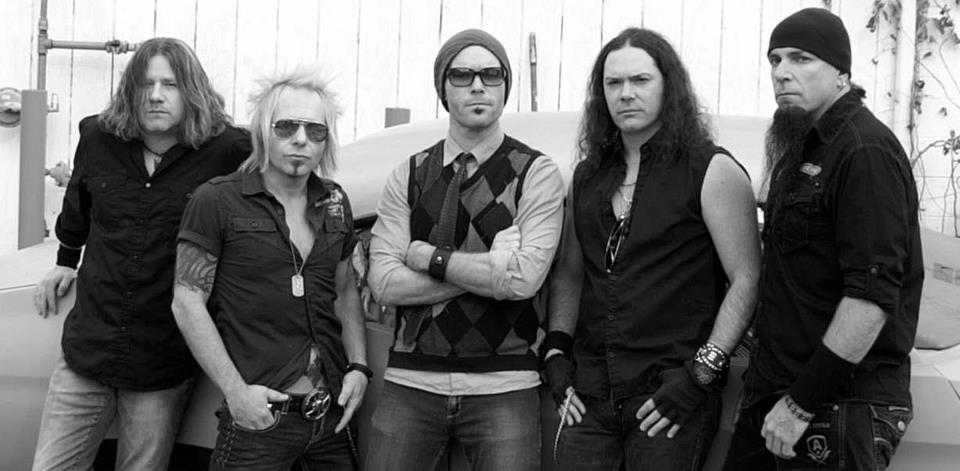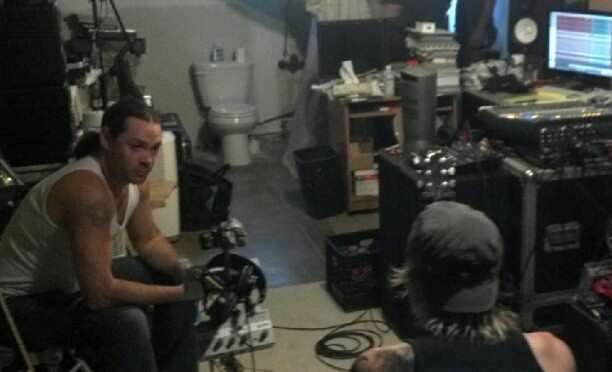When I started running sound for Octane back in September 2004, I never thought I’d ever record their music, I mean other than live. Over the years I started acquiring equipment for studio recording and along the way tracked some multi-track shows of theirs. Tin Angel shows, “Rise Up” CD Release show at Bootleggers and Brian Bortnick’s last night. I did this with a MOTU 24io straight out of the FOH console into Cubase SX3 and then remixed at home.
To bring you up to speed real quick, Brian Quinn left Octane in 2005 and started a band with Fuel’s drummer Kevin Miller called Fosterchild. Eventually Bob Pirylis left Octane in 2009 to join Fosterchild replacing Kevin Miller. I joined up with Fosterchild when there was more original members of Octane in Fosterchild than currently in Octane. Only Joe Bass remained. For me, as each member left, a little piece of Octane’s spirit did as well and while I love Joe Bass, I couldn’t stay any longer while Fosterchild’s energy was attracting me. I don’t take change lightly, so this was a huge step for me as was any movement to committing to a band.
It wasn’t until Fosterchild needed to do some tracking that I actually set up in my basement as a make-shift studio using the same method I did for those live shows. Set up my 32×8 console and direct out through the MOTU 24io to Cubase SX3 on a Windows computer. This is when the bug really bit and I’ve been developing my gear and methodology since almost daily. Over the last few years I have learned so much from reading books, websites, blogs, watching YouTube and training videos. I still learn everyday and each task is a learning experience.
It was those first sessions in my basement that is the audio on Fosterchild’s “After the Fire” video. Each track had to be exported individually, real time to be sent to Jim Ebert to mix. I landed a lot of planes.
While I used to say recording was much easier than running live sound, I am thinking they have their own idiosyncrasies. I used to say that since I was running live sound I had only one chance to get it right whereas the recording engineer had multiple shots at the same thing. Ctrl-Z and they can try again. While I guess I could maintain this when it comes to particular effects, recording brings much more of a microscope to sound. In a club or arena, things can be a little off but still pass muster. In recording if you’re a little off, it could make the difference in the overall tone and that’s not good.
With Fosterchild, the first recordings sounded a little dead and lifeless although at the time sounded great compared to nothing I really did prior. When I invested in a Mac and a Presonus StudioLive, the sound was impressively better. Using the Presonus on the road for digital recall also had the ability to record the live shows. Firewire right out to computer, easy peasy.
Fosterchild went to Dragonfly East to record “After the Fire” in a beautiful studio close to Manassas, VA. In deciding to record and release a new EP “Under the Influence Vol. 1” it was decided I would do these additional recordings and I’d get a shot at mixing them. In retrospect, I got real lucky on a lot of things. Bob used different drums (and those drums are a whole other story) and I got lucky with the guitar tones. Real lucky. My mixes worked and I mastered the entire CD. Jim Ebert’s mix of “After the Fire” and my mixes of the remaining 5 tunes. This was released March of 2010. I again learned a lot from this experience.
Since then I’ve done some individual projects for Brian Bortnick. Also Danny Beissel recorded some things and all the while I started mixing anything I could get my hands on. Fosterchild has recorded an additional 13 songs for a CD that has yet to be completed.
Within this time Octane held their first reunion at The Whiskey Tango February 12th, 2011. Their second at The Electric Factory March 17th, 2012. Their third at Moodswing in DE June 8th, 2012. Most recently, Xfinity Live on July 13th, 2012.
… and finally to the title of this post …
 On Monday July 30th, 2012 I got the call that Octane wanted to record the very next day and I obliged. So on Tuesday, July 31st 2012 we recorded multiple drum takes of “Little Sister Heartbreak” (which was a previously non-recorded Octane original) and a brand new song called “Get Up”. Brian Bortnick, Brian Quinn, Gregg Tripp and Bob Pirylis played these songs live and while all was recorded, then main point was to capture drums. That Friday August 3rd, Mike Vlaanderen came in and laid down the bass lines. Tuesday, August 7th Quinny did all his guitar parts. Thursday, August 9th Gregg did his guitar parts. Monday through Wednesday August 13-15 Brian Bortnick put the vocals on the two songs working 4-6 hours per session.
On Monday July 30th, 2012 I got the call that Octane wanted to record the very next day and I obliged. So on Tuesday, July 31st 2012 we recorded multiple drum takes of “Little Sister Heartbreak” (which was a previously non-recorded Octane original) and a brand new song called “Get Up”. Brian Bortnick, Brian Quinn, Gregg Tripp and Bob Pirylis played these songs live and while all was recorded, then main point was to capture drums. That Friday August 3rd, Mike Vlaanderen came in and laid down the bass lines. Tuesday, August 7th Quinny did all his guitar parts. Thursday, August 9th Gregg did his guitar parts. Monday through Wednesday August 13-15 Brian Bortnick put the vocals on the two songs working 4-6 hours per session.
I started this project on my MacBook Pro and after Quinn recorded I built a hackintosh and completed from Gregg on. I told Gregg he was the first to record through the new machine. I don’t think he was impressed. Fact of the matter is that the new machine is a monster and made the remaining recording and mixing much easier since I wasn’t up against the computer’s power as I’m now running 8 cores giving 7 exclusively to Pro Tools.
They were happy with how it sounded at this point. I mixed different versions tweaking things here and there and I would make available these mixes without them knowing exactly what it may have been that I was trying. So I’ve learned that I need not make each revision available as it serves to confuse them in my ultimate goal. Opinions came in, and I weighed them in subsequent mixes. Some did not agree. I then listened in my car and compared to the radio. It was apparent things needed to be better.
I went to ol’ reliable “Geek Stink Breath” by Green Day. Part of the problem was the panning of the guitars and there is phase cancellation in like frequencies when doing this. If you listen in mono, like on an iPhone, some of the guitars will be lost therefor increasing the volume of those things that are up the middle (drums, bass and vocals). I noticed this issue in Green Day’s music and thought that if it’s okay for them then why not me? I finally decided on something between 100/100 panning to just greater than 50/50. Maybe 65/65.
Then there was the low end. On its own, sounded fine – big – impressive – but then when up against the other songs on the radio sounded too round, even dull. I went through many bouts of saturation and analog goodness and reports came back that it was a very good thing. Then I poked out the guitars much farther than I ever think I would have gone on my own with Green Day as the influence.
Finally to mastering the end result which is so hot by today’s standards. Somewhere between -8 to -6 RMS. Again, using Green Day as the gauge. Also considering hearing my mixes on the radio and hearing where their multi-band compressors would pump my mix (specifically Fosterchild’s “Down to Us”). It’s figured that not leaving them much room to work will generate a true representation of what we all heard to be the “final” mix on the radio. I still feel that there is work to be done on these mixes. When I finally heard them in my car I felt there is low/mid issues with “Get Up” but I’m assured that they sound great.
I sincerely wish I were recording/mixing/mastering more as with each experience I believe I get better and better at what I’m doing. With each recording session I find things that need to be addressed to make myself faster when I have a room full of musicians chomping at the bit. Different ways of mic’ing and getter different sounds. Different techniques in mixing as sounds not thought to mask each other eventually do and what to do to deal with these results.
Some things come easy and some things frustrate to no end. I’ve come to give this realm of making music much more respect in that as time goes on my ears are opened to more and more. While anyone can build a room of wood and parquet floors professionally treated, acquire the best in gear worth thousands or even millions of dollars, top notch computers and the very best of software, it isn’t going to run itself. Another analogy is the guy playing guitar thinks buying a Gibson Les Paul will make him a better guitar player cause that’s what the “pros” use. Another analogy is the aspiring chef who thinks buying the best of cooking utensils will make his meals exquisite beyond belief. No! You have to have this innate ability within yourself. I feel this is reflected in the results and is why I maintain “It’s not the gear … it’s the ear!”
I’m still learning and sometimes I accidentally throw too much pepper into the mix. But when all is said and done, I realize what I’m accomplishing in my row home basement in NE Philadelphia not 5 feet from the toilet.

